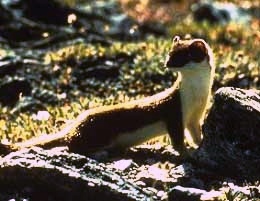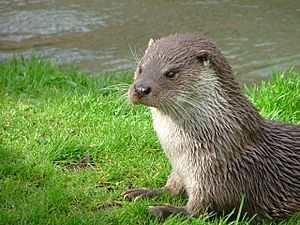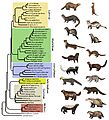Mustelid facts for kids
Quick facts for kids Mustelidae |
|
|---|---|
 |
|
| Long-tailed weasel | |
| Scientific classification |
|
| Kingdom: | Animalia |
| Phylum: | Chordata |
| Class: | Mammalia |
| Order: | Carnivora |
| Superfamily: | Musteloidea |
| Family: | Mustelidae G. Fischer de Waldheim, 1817 |
| Type genus | |
| Mustela Linnaeus, 1758
|
|
| Subfamilies | |
|
Lutrinae (otters) |
|

Mustelids are a family of carnivorous mammals. They are the family Mustelidae, in the order Carnivora.
They are the largest family of mammals. They are diverse, from weasels who eat mice to wolverines that can kill prey much larger than themselves. Mustelids live in many habitats: otters for example, live mostly in the water, while one species of weasel lives in the Arctic.
One kind of mustelid, the ferret, has been tamed and used for hunting for a long time. These days it is mostly kept as a pet. Because the ferret looks a bit like a rat that has been stretched out in the middle, it is sometimes called a tube rat.
These are other well-known animals from the mustelid family.
They can be thought of as two subfamilies, the Lutrinae (the otters), and the Mustelinae (the rest)
Images for kids
-
Sthenictis sp. (American Museum of Natural History)
-
Skeleton of a black-footed ferret (Mustela nigripes) on display at the Museum of Osteology
-
Detail from Leonardo da Vinci's Lady with an Ermine, 1489–1490
-
Time-calibrated tree of Mustelidae showing divergence times between lineages. Split times include: 28.8 million years (Ma) for mustelids vs. procyonids; 17.8 Ma for Taxidiinae; 15.5 Ma for Mellivorinae; 14.8 Ma for Melinae; 14.0 Ma for Guloninae + Helictidinae; 11.5 Ma for Guloninae + Naquinae vs. Helictidinae; 12.0 Ma for Ictonychinae; 11.6 Ma for Lutrinae vs. Mustelinae.
See also
 In Spanish: Mustélidos para niños
In Spanish: Mustélidos para niños






